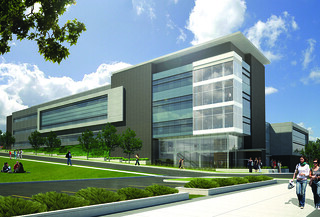uOttawa News
Media Releases and Announcements
uOttawa breaks ground on world-leading science and engineering complex, takes next step in making Ottawa a photonics and geoscience powerhouse
OTTAWA, September 25, 2012 — The University of Ottawa officially broke ground today on its Advanced Research Complex (ARC), taking the next step in becoming Canada’s science and engineering powerhouse.
The uOttawa ARC will house two separate and equally exciting leading research efforts—the revamped uOttawa Centre for Advanced Photonics and a cluster of state-of-the-art geoscience laboratories.
“There’s a reason that this complex is being built in Ottawa at our University,” says Allan Rock, president and vice-chancellor of the University of Ottawa. “Nowhere else will you find the combination of world renowned researchers, extensive experience in science and engineering and key partners from the private and public sectors.”
“The groundbreaking of this world-class facility sets Ottawa on the path to becoming the geoscience capital of Canada and the photonics capital of the world,” says Rock.
The University of Ottawa would like to acknowledge the commitment of the Canadian and Ontario governments and their outstanding contributions, making possible the construction of the ARC, the purchase of state-of-the-art equipment, scholarships awards and new research projects.
Through the Canada Foundation for Innovation’s (CFI) New Initiatives Fund and Leading Edge Fund, the Harper Government is investing $5.5 million toward the construction of this new complex. An additional $7.2 million will go toward state-of-the-art equipment for two of the labs that will be located here. “Through investments in basic science research infrastructure at institutions across the country, our government is contributing to Canada’s brain gain and ranking at the top of the G7 for higher education expenditures on research and development. These investments also contribute to a stronger, more innovative economy, which provides important social benefits to all Canadians,” said the Honourable Gary Goodyear, Minister of State (Science and Technology).
Making Ottawa the photonics capital of the world
Since the photonics revolution that began in the 1970s with the National Research Council of Canada and continues with companies such as Cienna, Cisco and JDS, the University of Ottawa has been building an exceptional team of world-class researchers able to bridge the gap between theory, research and applied science in the field of photonics.
The ARC will provide these experts from various disciplines, such as physics and engineering, with cutting-edge facilities and equipment. The ARC facilities feature isolation from all environmental vibrations and minuscule changes in temperature and humidity.
“This new environment will lead to exchanges between experts in photonics and to synergies like we’ve never seen. The work we do with other centres of excellence in the world can only be improved,” says Paul Corkum, Canada Research Chair in Attosecond Photonics.
Canada’s only accelerator mass spectrometer
The University of Ottawa’s ARC will be home to modern geoscience laboratories including the next generation of accelerator mass spectrometer (AMS), a Canadian technology now used world-wide to measure trace radionuclides. The team that has been working with the current mass spectrometer at the University of Toronto for more than 30 years will move to Ottawa once ARC is open and the new instrument is operational. This means that Canada’s one and only instrument of this kind will be located in Ottawa.
With the AMS, scientists will be able to conduct the most advanced environmental research and unlock important natural resource, climate and health mysteries.
“Already well known as the hub of geoscience research, Ottawa was chosen as the location for the next accelerator mass spectrometer following consultations held across Canada,” explains Ian Clark, a pioneer in using isotopes in environmental research and the Earth sciences. “This instrument and the cutting-edge labs will bring researchers from all over the world to our Centre!”
The scientific discoveries of the two teams of renowned photonics and geoscience researchers will bring new technologies that will lead to improvements in our well-being. Examples include more accurate medical diagnoses, faster telecommunications, safe disposal of nuclear waste and the development of solar energy.
The University of Ottawa, on its way to becoming a science and engineering force
Construction on the ARC coincides with the publication of a report ranking the University of Ottawa fourth in Canada in science and engineering. As one of Canada's top 10 research institutions, the University of Ottawa has gained significant momentum in the quality and quantity of research conducted in these two fields.
Xerox, which sponsored today’s event, announced this afternoon that it will provide funding for a graduate fellowship in photonics.
“More than three decades ago we promised to make strategic investments in Canada’s knowledge infrastructure,” said Emechete Onuoha, Vice President, Citizenship and Government Affairs, Xerox Canada. “Today, Xerox is the only multi-national, services-led document technology company in the world conducting value-added, advanced research in Canada as part of a global mandate. Through ARC, uOttawa is establishing a world-class research platform consistent with our own ongoing efforts to advance the frontiers of innovation in Canada.”
Visit our Flicker page to see images of ARC and photos of the groundbreaking ceremony.

